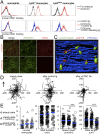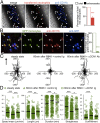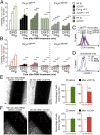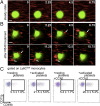CCN1/CYR61-mediated meticulous patrolling by Ly6Clow monocytes fuels vascular inflammation
- PMID: 27482114
- PMCID: PMC4995973
- DOI: 10.1073/pnas.1607710113
CCN1/CYR61-mediated meticulous patrolling by Ly6Clow monocytes fuels vascular inflammation
Erratum in
-
Correction for Imhof et al., CCN1/CYR61-mediated meticulous patrolling by Ly6Clow monocytes fuels vascular inflammation.Proc Natl Acad Sci U S A. 2019 Mar 26;116(13):6501. doi: 10.1073/pnas.1903306116. Epub 2019 Mar 18. Proc Natl Acad Sci U S A. 2019. PMID: 30886099 Free PMC article. No abstract available.
Abstract
Inflammation is characterized by the recruitment of leukocytes from the bloodstream. The rapid arrival of neutrophils is followed by a wave of inflammatory lymphocyte antigen 6 complex (Ly6C)-positive monocytes. In contrast Ly6C(low) monocytes survey the endothelium in the steady state, but their role in inflammation is still unclear. Here, using confocal intravital microscopy, we show that upon Toll-like receptor 7/8 (TLR7/8)-mediated inflammation of mesenteric veins, platelet activation drives the rapid mobilization of Ly6C(low) monocytes to the luminal side of the endothelium. After repeatedly interacting with platelets, Ly6C(low) monocytes commit to a meticulous patrolling of the endothelial wall and orchestrate the subsequent arrival and extravasation of neutrophils through the production of proinflammatory cytokines and chemokines. At a molecular level, we show that cysteine-rich protein 61 (CYR61)/CYR61 connective tissue growth factor nephroblastoma overexpressed 1 (CCN1) protein is released by activated platelets and enables the recruitment of Ly6C(low) monocytes upon vascular inflammation. In addition endothelium-bound CCN1 sustains the adequate patrolling of Ly6C(low) monocytes both in the steady state and under inflammatory conditions. Blocking CCN1 or platelets with specific antibodies impaired the early arrival of Ly6C(low) monocytes and abolished the recruitment of neutrophils. These results refine the leukocyte recruitment cascade model by introducing endothelium-bound CCN1 as an inflammation mediator and by demonstrating a role for platelets and patrolling Ly6C(low) monocytes in acute vascular inflammation.
Keywords: CCN1; inflammation; monocyte; neutrophil; platelet.
Conflict of interest statement
The authors declare no conflict of interest.
Figures















Similar articles
-
Toll-like receptors elicit different recruitment kinetics of monocytes and neutrophils in mouse acute inflammation.Eur J Immunol. 2017 Jun;47(6):1002-1008. doi: 10.1002/eji.201746983. Epub 2017 Apr 18. Eur J Immunol. 2017. PMID: 28299776
-
Triggering of NOD2 Receptor Converts Inflammatory Ly6Chigh into Ly6Clow Monocytes with Patrolling Properties.Cell Rep. 2017 Aug 22;20(8):1830-1843. doi: 10.1016/j.celrep.2017.08.009. Cell Rep. 2017. PMID: 28834747
-
Correction for Imhof et al., CCN1/CYR61-mediated meticulous patrolling by Ly6Clow monocytes fuels vascular inflammation.Proc Natl Acad Sci U S A. 2019 Mar 26;116(13):6501. doi: 10.1073/pnas.1903306116. Epub 2019 Mar 18. Proc Natl Acad Sci U S A. 2019. PMID: 30886099 Free PMC article. No abstract available.
-
Platelet-neutrophil-interactions: linking hemostasis and inflammation.Blood Rev. 2007 Mar;21(2):99-111. doi: 10.1016/j.blre.2006.06.001. Epub 2006 Sep 20. Blood Rev. 2007. PMID: 16987572 Review.
-
Nonclassical patrolling monocyte function in the vasculature.Arterioscler Thromb Vasc Biol. 2015 Jun;35(6):1306-16. doi: 10.1161/ATVBAHA.114.304650. Epub 2015 Apr 2. Arterioscler Thromb Vasc Biol. 2015. PMID: 25838429 Free PMC article. Review.
Cited by
-
Paternal hypercholesterolemia elicits sex-specific exacerbation of atherosclerosis in offspring.JCI Insight. 2024 Sep 10;9(17):e179291. doi: 10.1172/jci.insight.179291. JCI Insight. 2024. PMID: 39253968 Free PMC article.
-
Patrolling monocytes promote the pathogenesis of early lupus-like glomerulonephritis.J Clin Invest. 2019 Apr 29;129(6):2251-2265. doi: 10.1172/JCI125116. eCollection 2019 Apr 29. J Clin Invest. 2019. PMID: 31033479 Free PMC article.
-
Recent Understandings of Biology, Prophylaxis and Treatment Strategies for Hypertrophic Scars and Keloids.Int J Mol Sci. 2018 Mar 2;19(3):711. doi: 10.3390/ijms19030711. Int J Mol Sci. 2018. PMID: 29498630 Free PMC article. Review.
-
RBP-J regulates homeostasis and function of circulating Ly6Clo monocytes.Elife. 2024 Feb 26;12:RP88135. doi: 10.7554/eLife.88135. Elife. 2024. PMID: 38407952 Free PMC article.
-
Angiogenic factor-driven inflammation promotes extravasation of human proangiogenic monocytes to tumours.Nat Commun. 2018 Jan 24;9(1):355. doi: 10.1038/s41467-017-02610-0. Nat Commun. 2018. PMID: 29367702 Free PMC article.
References
-
- Soehnlein O, Lindbom L, Weber C. Mechanisms underlying neutrophil-mediated monocyte recruitment. Blood. 2009;114(21):4613–4623. - PubMed
-
- Geissmann F, Jung S, Littman DR. Blood monocytes consist of two principal subsets with distinct migratory properties. Immunity. 2003;19(1):71–82. - PubMed
-
- Sunderkötter C, et al. Subpopulations of mouse blood monocytes differ in maturation stage and inflammatory response. J Immunol. 2004;172(7):4410–4417. - PubMed
Publication types
MeSH terms
Substances
LinkOut - more resources
Full Text Sources
Other Literature Sources
Medical
Molecular Biology Databases

